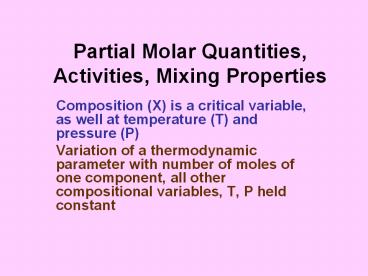Partial Molar Quantities, Activities, Mixing Properties - PowerPoint PPT Presentation
Title:
Partial Molar Quantities, Activities, Mixing Properties
Description:
Partial Molar Quantities, Activities, Mixing Properties Composition (X) is a critical variable, as well at temperature (T) and pressure (P) Variation of a ... – PowerPoint PPT presentation
Number of Views:2056
Avg rating:3.0/5.0
Title: Partial Molar Quantities, Activities, Mixing Properties
1
Partial Molar Quantities, Activities, Mixing
Properties
- Composition (X) is a critical variable, as well
at temperature (T) and pressure (P) - Variation of a thermodynamic parameter with
number of moles of one component, all other
compositional variables, T, P held constant
2
(No Transcript)
3
(No Transcript)
4
Partial Molar Volume
5
Example - spinel solid solution
6
Spinel volumes
7
(No Transcript)
8
(No Transcript)
9
Activity Composition Relations
10
The Entropy of Mixing in Solid Solutions Contrib
utions vibrational magnetic and
electronic configurational For the random
mixing of a total of one mole of species over a
total of one mole of sites, ?Smix -RxA
ln xA xB ln xB and ?s(A) -R ln
xA , ?s(B) -R ln xB
11
(No Transcript)
12
The thermodynamic activity is defined as ?µº(A)
RT ln a(A) and ?µº(B) RT ln a(B)
The changes in chemical potential on
mixing can be related to partial molar enthalpies
and entropies of mixing ?µºT(A) ?hºT(A) -
T?sºT(A) , ?µºT(B) ?hºT(B) - T?sºT(B)
13
Chemical Potential Partial Molar Free Energy
14
If the enthalpy of mixing is zero, then the
simple ideal solution results, ?Gºmix RT xA
ln xA xBln xB ?µº (A) RT ln xA ,
?µº (B) RT ln xB a(A) xA , a(B)
xB. Raoults Law holds only when one mole
total of species being mixed randomly, so always
introduces a microscopic meaning you can not get
away from. Thus Raoults Law applies directly to
BaSO4-RaSO4 solid solutions, FeCr2O4-NiCr2O4
spinel solid solutions if one assumes Ni and Fe
mix on tetrahedral sites only, and UO2-PuO2 solid
solutions if there is no variation in oxygen
content.
15
Regular, Subregular and Generalized Mixing
Models Starting point useful but inherently
contradictory assumption that, though the heats
of mixing are not zero, the configurational
entropies of mixing are those of random solid
solution. ?Gºmix, ex ?Hºmix-T?Sºmix, ex
For a two-component system, the
simplest formulation is ?Gexcess ?Hmix
?xAxB WH xAxB
16
Generalization
- For a binary system, the Guggenheim or
Redlich-Kister based on a power-series expression
for the excess molar Gibbs energy of mixing
which reduces to zero when either x1 or x2
approach unity - where the coefficients ?r are called
interaction parameters. Activity coefficients can
be obtained by the partial differentiation of
over the mole fraction x1 or x2
17
Systematics in Mixing Propertieszz (Davies and
Navrotsky 1981)
18
Size Mismatch and Interaction Parameter
19
Henrys Law Regions
20
IMMISCIBILITY Immiscibility (phase separation)
occurs when positive WG terms outweigh the
configurational entropy contribution. For the
strictly regular solution, the miscibility gap
closes at a critical point or consolute
temperature. T WH/2R Conditions for
equilibrium between two phases (a and ß)
simultaneous equalities of chemical potential
or activities µ(A, phase a) µ(A, phase
ß) µ(B, phase a) µ(B, phase
ß) a(A, phase a) a(A, phase
ß) a(B, phase a) a(B, phase ß)
21
(No Transcript)
22
(No Transcript)
23
RESULTS
- FREE ENERGY CURVES
- Complete miscibility
- Solvus- phases derived from same structure and
one free energy curve - Immiscibility resulting from different structures
24
Phases with Different Structures Partial
solid solution can exist among end members of
different structureA with structure a and B
with structure ß. µ(A,a) µº(A,a) RT ln
a(A,a) µ(A,ß) µº(A,a) ?µ(A,a?ß) RT
ln a(A,ß) µ(B,a) µº(B,ß) ?µ(B,
ß?a) RT ln a(B,a) µ(B,ß) µº(B,ß) RT
ln a(B,ß) The limiting solubilities are
given by equating chemical potentials µ(A,a)
µ(A,ß) µ(B,a) µ(B,ß) The
miscibility gap can not close and is not a
solvus.
25
ZnO CoO solid solutions
If the surface energy in wurtzite phase is
smaller than in rocksalt, wurtzite will be
favored at the nanoscale. Solid solubility of ZnO
in rocksalt will decrease while that of CoO in
wirtzite will increase
Relevant to Chencheng Ma thesis work
26
Spinodal
27
Spinodal
28
References
- Guggenheim, E.A., Thermodynamics An advanced
treatment for chemists and physicists. 5th edn.
Amsterdam North-Holland 390,1967 - Thompson, J.B., Thermodynamic properties of
simple solutions. In Researches in geochemistry.
Edited by Abelson PH. New York John Wiley and
Sons 1967 340-361. - Thompson, J.B., Chemical reactions in crystals.
Amer. Mineral., 54 (1969) 341-375. - Eriksson, G., Rosen, E., Thermodynamic studies of
high temperature equilibria. VIII General
equations for the calculation of equilibria in
multiphase systems. Chemica Scripta, 4(4) (1973)
193-194. - Pelton, A. D., Bale, C. W., Computational
techniques for the treatment of thermodinamic
data in multicomponent systems and the
calculation of phase equilibria. Calphad, 1(3)
(1977) 253-273. - Wood, B.J., Nicholls, J., The thermodynamic
properties of reciprocal solid solutions.
Contributions to Mineralogy and Petrology 66
(1978) 389-400. - Nordstrom, D.K., Munoz, J.L., Geochemical
thermodynamics. 2nd edn. Boston Blackwell
Scientific Publications (1994) 483. - Ott, J.B., Boerio-Goates, J., Chemical
thermodynamics Advanced applications. San Diego
CA Academic Press, 438 (2000). - Ott, J.B., Boerio-Goates J., Chemical
thermodynamics Principles and applications. San
Diego CA Academic Press, 664 (2000). - Ganguly, J., Thermodynamic modelling of solid
solutions. In EMU Notes in Mineralogy Solid
solutions in silicate and oxide systems of
geological importance. Edited by Geiger CA.
Budapest Eotvos University Press, 3 (2001)
37-69. - Geiger, C.A., Solid solutions in silicate and
oxide systems of geological importance. In
European mineralogical union notes in mineralogy.
Edited by Papp G, Weiszburg TG. Budapest Eotvos
University Press, 3 (2001) 458.































